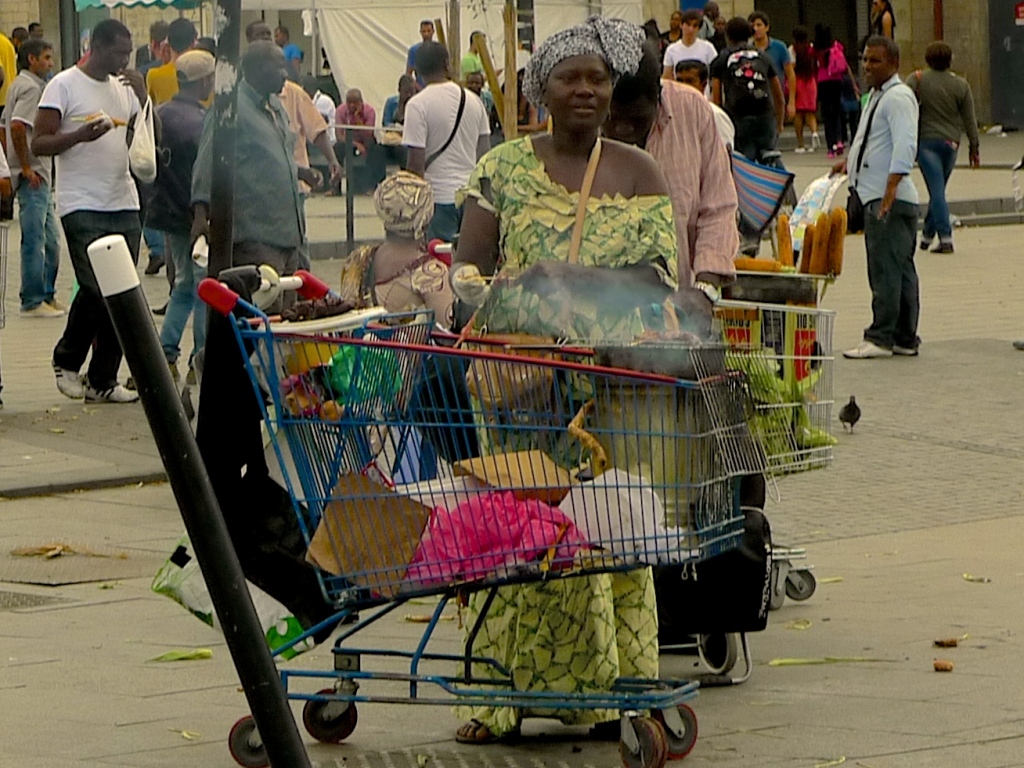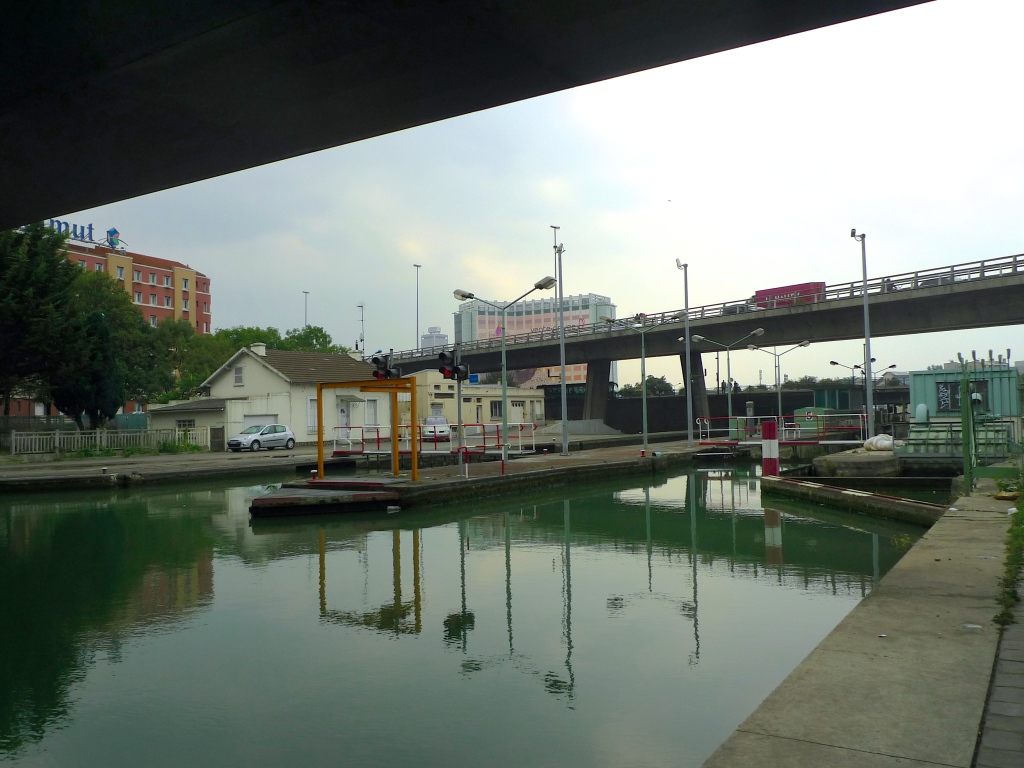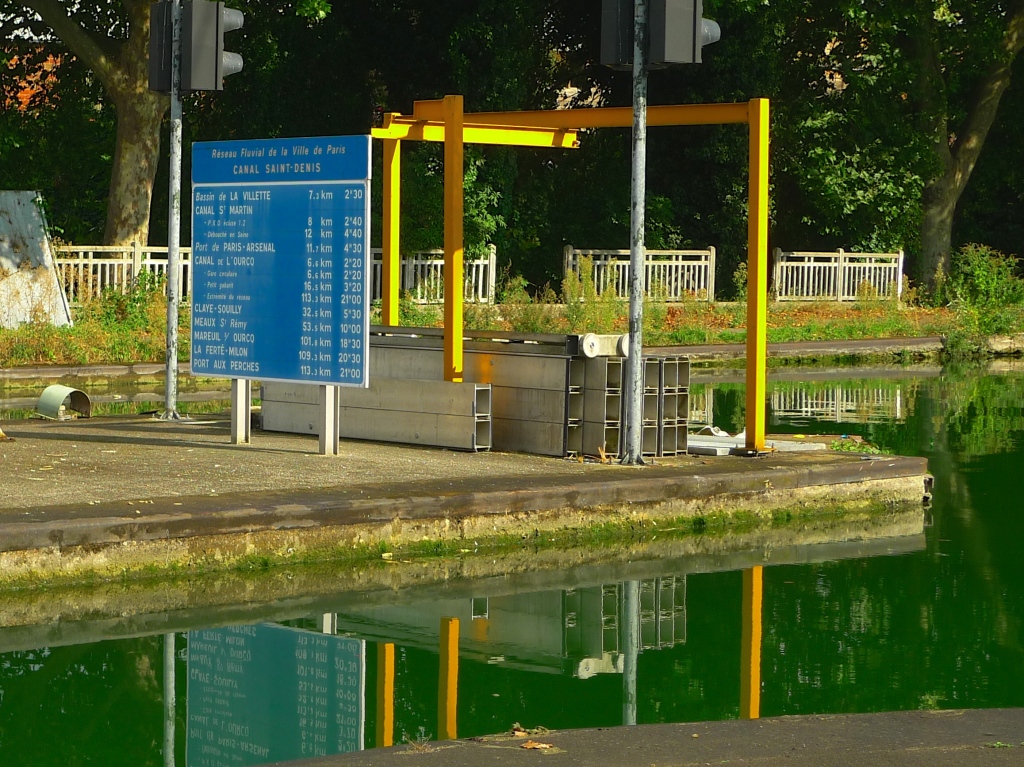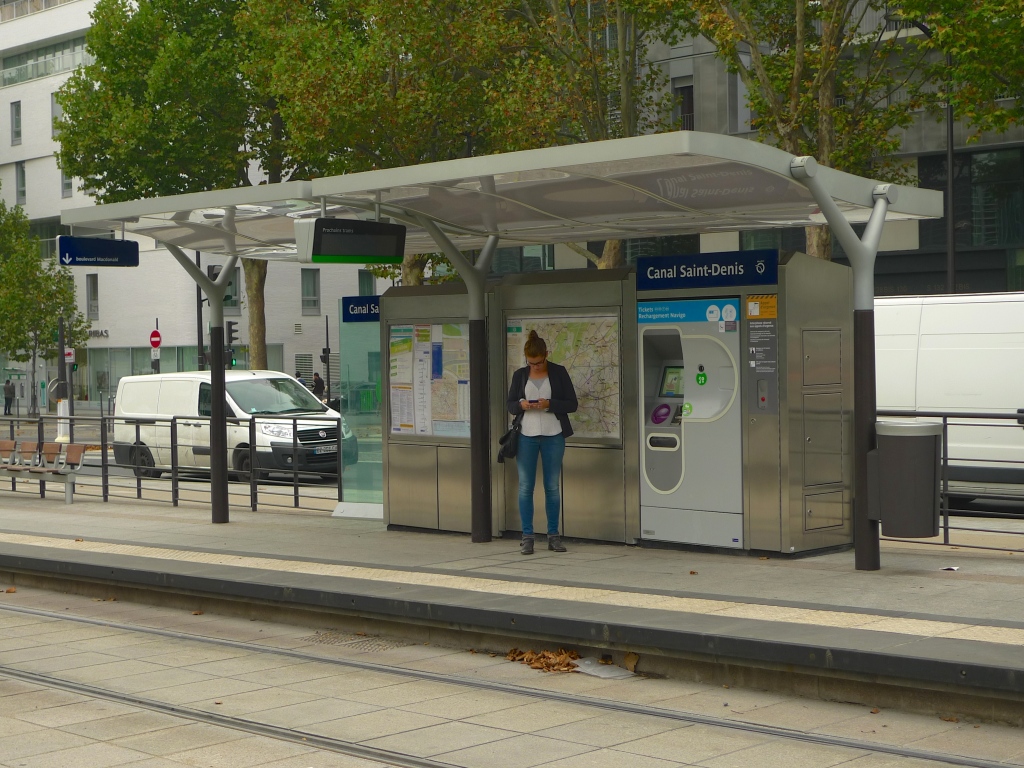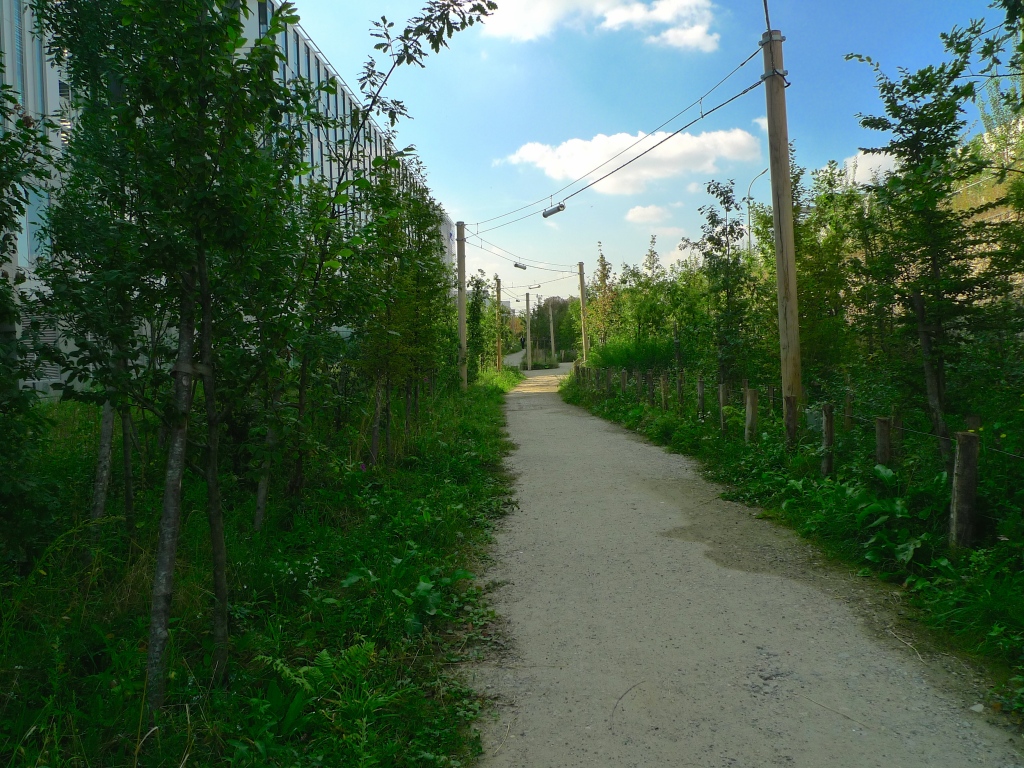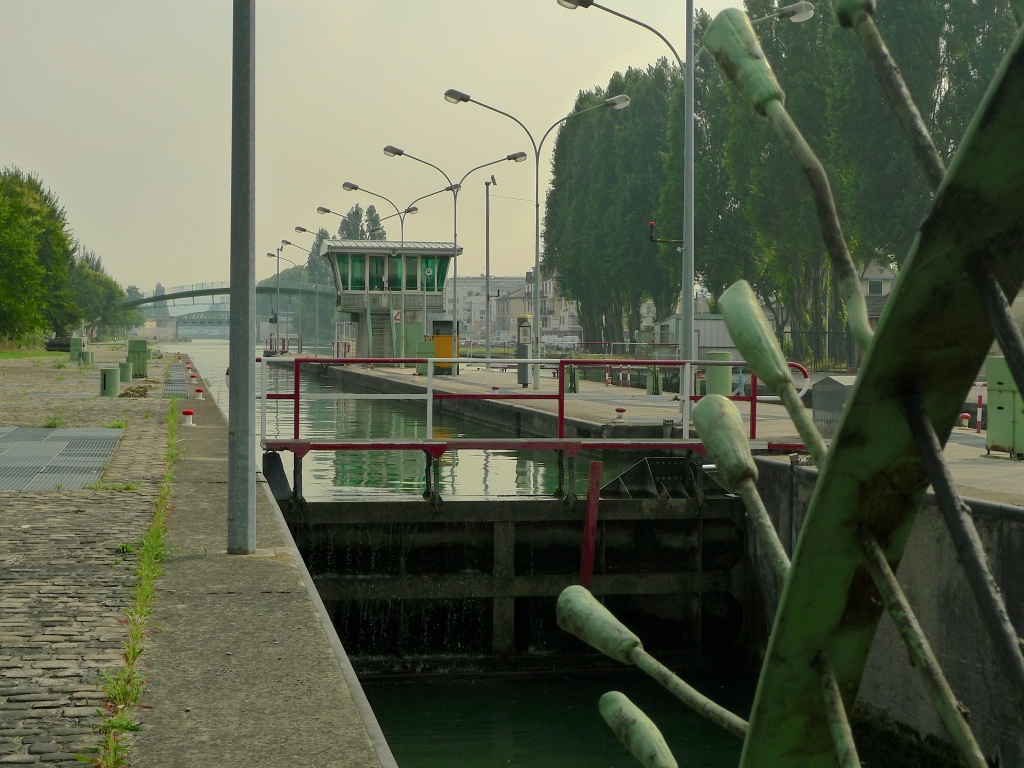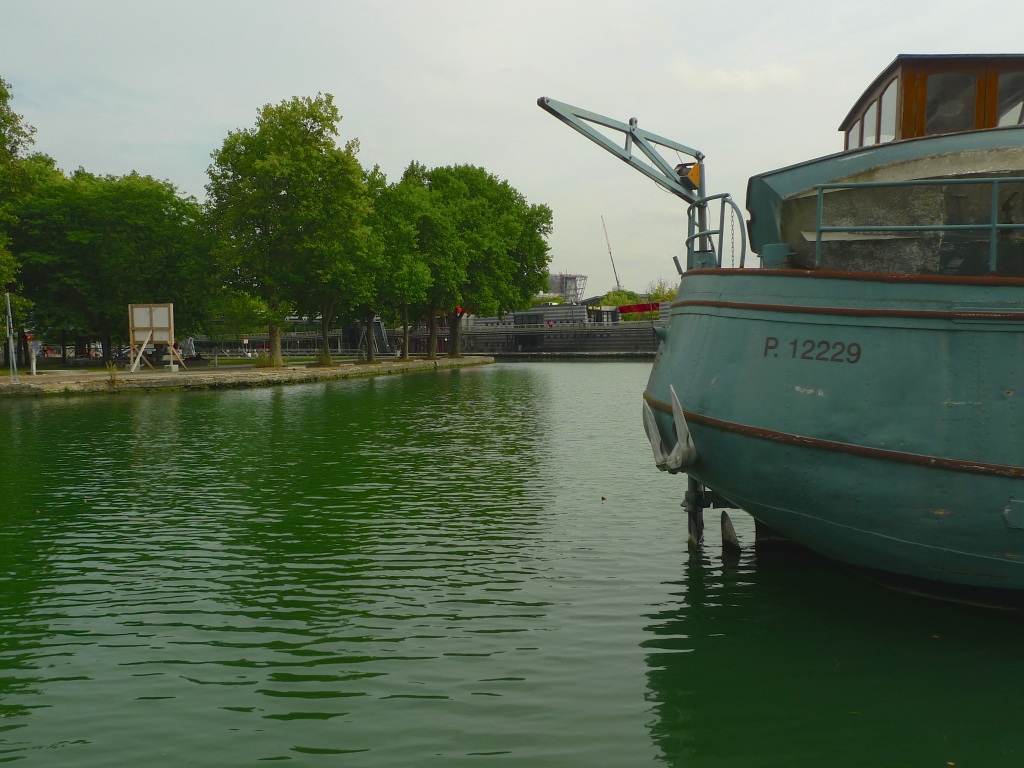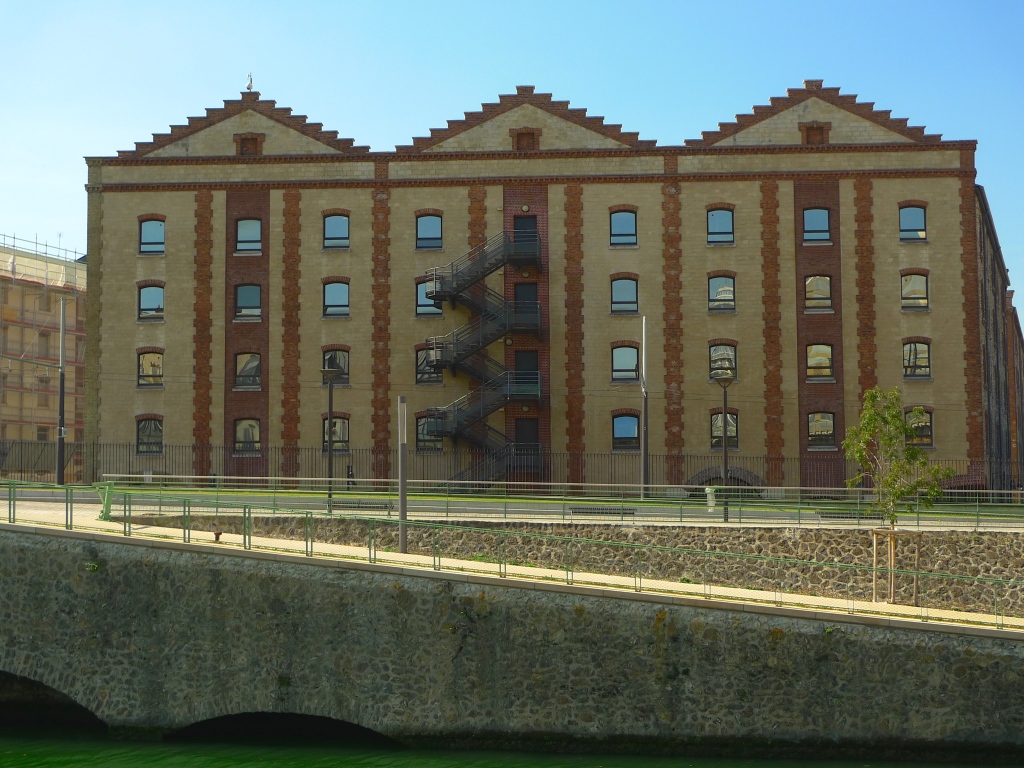The Canal Saint-Denis and its Sounds – A Postscript
MY LAST THREE POSTS have covered my recent exploration of the Canal Saint-Denis and its sounds.
In Part 1, I walked along the western side of the canal from its starting point in the Parc de la Villette to the end of the Quai de la Gironde in the 19th arrondissement of Paris. In Part 2, I crossed over the Pont MacDonald, left the Paris city limits, and walked along the eastern side of the canal to the swing bridge, the Pont Tournant du Canal Saint-Denis, in the commune of Aubervilliers. In Part 3, I left Aubervilliers and continued walking along the eastern side of the canal until I reached the heart of Saint-Denis where I had to cross over to the western side again in order to continue to the end of the canal at L’Écluse de la Briche where the canal discharges into la Seine. As I walked along the canal I stopped from time to time to capture the sights and sounds of the canal and I made several detours to look at and to listen to other things that caught my interest.
I’ve included some of the sights and sounds I captured along the canal in my previous three posts but now I want to add something else I captured, something that I think captures the very essence of the Canal Saint-Denis.
As I passed the penultimate lock on the canal, Lock N°6, L’Écluse Saint-Denis, I discovered that my way was barred because of renovation work to the walls of the quay and so I had to cross over the Passerelle de la Gare to the other side. As I crossed over this footbridge I had no idea that it would be a further hour before I continued my journey along the canal.
My diversion over the Passerelle de la Gare, across the Place de la Gare, then over the Pont de la Gare Saint-Denis and back again to the western quay
Saint-Denis; Place de la Gare
I crossed the footbridge and entered the Place de la Gare, the concourse outside Saint-Denis railway station, when I came upon something completely unexpected and something that occupied me for the next hour or so.
I found that I was in the midst of an African street market complete with its colourful sights and sounds.
Street Market in the Place de la Gare – Saint-Denis:
The market stretched across the Place de la Gare and over the Pont de la Gare Saint-Denis but it’s not an official market, on the contrary, it’s an ad hoc and technically illegal market that appears most days of the week. The police though seem to tolerate it, they patrol the area regularly, always in groups of three, whereupon the vendors hastily pack their goods away and wait until the police leave before they get back to work.
Of course, the police haven’t always been so tolerant and I was reminded of this when I saw a sign attached to lamppost with an alternative name for this space – Place des Victimes du 17 October 1961.
October 1961 was a particularly inglorious time for the police as the two memorial plaques I found explain.
Memorial plaque in the Place de la Gare
Memorial plaque on the Pont de la Gare Saint-Denis
I’ve referred to these events elsewhere in this blog so here I’ll just leave the plaques to tell their own story.
In my walk along the entire length of the Canal Saint-Denis, I photographed many images and recorded many sounds but, for me, it is the sounds of this market that capture the real essence of the Canal Saint-Denis.
At the end of Part 3 of my exploration of the canal I said:
“My walk along the canal made me think not only about my immediate surroundings but also about history; the medieval history of the fertile Plaine Saint-Denis, the industrial revolution in the nineteenth-century and the more recent de-industrialisation with the urban decline and attempts at renewal that have followed in its wake.”
With a little imagination, I think the contemporary sounds I discovered in the Place de la Gare illustrate some of that history.
At first glance, it might not be obvious how to connect these sounds with a medieval past but markets and their sounds are nothing new to Saint-Denis or to the surrounding area.
The first market hereabouts, la foire de la Saint-Denis, the Fair of Saint-Denis, dates back to the seventh century when an autumn fair was held beginning on October 9th each year, the anniversary of the martyrdom of Saint-Denis and the date of the annual pilgrimage to his tomb. The fair was held at the Place Panetière and in covered markets, but also in the main cemetery of the Abbeye de Saint-Denis. It lasted for seven-weeks, from October 9th to November 29th, Saint Andrew’s Day, and since it was held well after the harvest and during grape-picking it allowed the abbey to sell its grain and surplus wine produced by its extensive vineyards.
The subsequent arrival of the Vikings interrupted this annual fair but the monks of Saint-Denis revived it again in 1053 with the Lendit Fair. In the early twelfth century, the market was moved to the La Plaine Saint-Denis, halfway between Paris and Saint-Denis, where it began on the second Wednesday in June and lasted until June 23, the eve of the feast of Saint John the Baptist. The market returned to the Place Panetière in 1556.
Today, as well as the ad hoc street market in the Place de la Gare, Saint-Denis is well-known for its thriving indoor and street markets clustered around the former Place Panetière, now the Place Victor Hugo.
When it was opened in 1821, the Canal Saint-Denis created a ribbon of water cutting through the edge of the 19th arrondissement of Paris and stretching across the agricultural Plaine Saint-Denis and through medieval Aubervilliers as far as Saint-Denis. In its wake came the railway and a wave of industrialisation. The canal became a major artery feeding the burgeoning industries; it became the lifeblood of the communities along its banks.
Today, save for the stretch along the Quai de la Gironde in the 19th arrondissement, a walk along the Canal Saint-Denis reveals little of the sonic environment that might have existed in the nineteenth century. Of course, barges still pass up and down the canal and trains cross it, there is mechanical activity – trucks take on loads of ready-mix concrete and JCB’s load and off-load construction materials, but there is little of the bustle of human activity that would have characterised the canal during the hundred years from the mid-nineteenth to the mid-twentieth century.
The sounds I came upon in the Place de la Gare reminded me that this canal, in its hey-day, would have had a pulse reflecting the heartbeat of the human communities along its banks.
After industrialisation came de-industrialisation along with its bedfellows, increased unemployment, increased poverty, the flight of the wealthiest part of the population and increased immigration.
Issues around immigration seem to make big headlines today but immigration is nothing new along the Canal Saint-Denis. Nineteenth century industrialisation saw waves of immigrants arrive just as de-industrialisation has. The sounds I found in the Place de la Gare seemed to me to reflect the ebb and flow of these populations.
I’ve said that the sounds I happened upon in the Place de la Gare were sounds that for me at least captured the very essence of the Canal Saint-Denis. Out of context they are simply the sounds of yet another street market but in the context that they are the sounds of human activity lying alongside and straddling the Canal Saint-Denis they seem to me to represent a series of footprints stretching from the present day to the distant past.
The essence of the Canal Saint-Denis surely rests with its location, its history and the activity on and around it. The sounds of this ad hoc market in the Place de la Gare with accents from the Maghreb, sub-Saharan Africa and elsewhere may represent this stretch of the Canal Saint-Denis today but I would argue that they are also a reflection of the medieval markets in the Plaine Saint-Denis which themselves were not attended exclusively by the French.
The modern-day sounds I think also represent a similar heartbeat to that which might have been found alongside the canal at the height of industrialisation – bustling activity against a background of competing accents. The period of de-industrialisation, of course, is to some extent represented by the very people I found in the Place de la Gare.
The one piece of history that is perhaps not represented by these sounds is the retrieval of the dead bodies from the canal in October 1961. Maybe that’s appropriate though because I suspect that they would have been treated with a respectful silence.
Place de la Gare – Place des Victimes du 17 October 1961
In my exploration of the Canal Saint-Denis I recorded many sounds all of which are a faithful record of the canal as it is today. But, for me, none of them conjure up as much of the essence of the canal as the sounds in the Place de la Gare.
The Canal Saint-Denis and its Sounds – Part 3
MY EXPLORATION OF THE Canal Saint-Denis and its sounds began at the head of the canal where it parts company from the Canal de l’Ourcq at the Parc de la Villette. In Part 1, I followed the canal to the end of the Quai de la Gironde on the edge of the 19th arrondissement of Paris and in Part 2, I crossed the Paris city limits and followed the canal across the western edge of Aubervilliers to the swing bridge, the Pont Tournant du Canal Saint-Denis.
Having completed a little over half my journey, I’m now going to follow the canal into the commune of Saint-Denis to the final lock on the canal, l’Écluse de la Briche, where it discharges into la Seine.
My route for the final leg of my journey along the Canal Saint-Denis
Walking along the quay from the swing bridge, I crossed from Aubervilliers into the commune of Saint-Denis and the French National Stadium, the Stade de France.
The Stade de France, the French National Stadium
With a seating capacity of 80,000, the Stade de France is a major international sporting and concert venue. It was opened in January 1998 in time to stage the 1998 FIFA World Cup Final in July of that year, a final which appropriately France won beating Brazil 3-0.
Built on the site of a former gasworks and costing €290 million, the stadium took just thirty-one months to build during which time some 800,000 M2 of earth was moved and some 180,000 M3 of concrete poured. The stadium has retractable seating, which moves to reveal an athletics track around the central playing field.
The most notable feature of the stadium is the elliptical roof, which is suspended some 42 metres above the ground, covers an area of six hectares and weighs 13,000 tons.
The one glaring omission in the design of the stadium is the lack of any under floor heating, something that was highlighted, much to the stadium’s embarrassment, when in 2012 a Six Nations international rugby game between France and Ireland had to be cancelled just before kick-off due to the pitch freezing.
As well as hosting the 1998 FIFA World Cup Final, the stadium also hosted the 2003 Athletics World Championships, the 2007 Rugby World Cup Final and the UEFA Champions League Finals in 2000 and 2006. Had Paris won its bid to host the 2012 Olympic Games, the Stade de France would have been the main Olympic stadium.
As a major concert venue, the stadium has hosted the likes of The Rolling Stones, Paul McCartney, Madonna, U2, Céline Dion, Coldplay, Beyoncé, Eminem, Lady Gaga and many more.
Having stopped for a while to look at the Stade de France from across the canal, I moved on a short way and followed the canal to the next lock, Lock N° 5, l’Écluse de la Porte-de-Paris.
Lock N° 5, l’Écluse de la Porte-de-Paris looking downstream.
This lock is enveloped in sound, not only the sound of canal traffic though, although plenty of canal traffic passes through the lock, but rather the sound of endless traffic passing over two road bridges adjacent to the lock.
One of these bridges, the Pont Wilson, carries l’avenue du Président Wilson, part of the trunk road running from Paris to Calais, and the other is the huge bridge carrying the France’s busiest Autoroute, the A1, which runs from Paris to Lille.
The Pont de l’A1
Despite the fact that Aubervilliers and Saint-Denis are probably the poorest municipalities around Paris and both have a very high crime rate, I never felt uneasy walking through either as I explored the Canal Saint-Denis – at least not until I arrived here. And it wasn’t the people I encountered that made me uneasy, instead it was the atmosphere around where these two major arteries pass overhead. Both bridges feel oppressively low to the ground. One, probably because of its size, feels as though it is – and the other just is! The base of the Pont Wilson in fact forms the roof of the downstream entrance to Lock N° 5 and I couldn’t help feeling claustrophobic and very uneasy as I walked underneath it. In addition, the noise pollution here from the traffic passing overhead is particularly oppressive and certainly didn’t add to my sense of well being.
The downstream entrance to Lock N°5 with the Pont Wilson forming the roof
The downstream entrance to Lock N°5 with both the Pont Wilson and the A1 passing overhead
On the downstream side of Lock N° 5, the canal makes a left turn and widens out to form le bassin de la Maltournée, a zone de débarquement, a zone for loading and unloading construction materials, mainly sand and aggregates.
Looking back from here you can see both the Pont Wilson and the A1 passing over l’Écluse de la Porte-de-Paris with the Stade de France just beyond.
I can’t account for the clothes draped over the rail. They didn’t seem to belong to anybody and there were many other items of clothing scattered around along with much assorted detritus.
Le Bassin de la Maltournée looking upstream
And this is what le Bassin looked like in former, busier, times.
Le Bassin de la Maltournée courtesy of Wikipedia
Because of the width of the canal at this, its widest point, vessels are able to manoeuvre to and from the landing stages whilst allowing other vessels to pass in and out of the lock.
The barge ‘Diane’ heading for the lock while a barge behind her manoeuvres alongside the loading quay
The fifth lock on the Canal Saint-Denis, l’Écluse de la Porte-de-Paris, takes its name from the nearby Porte-de-Paris. Before the industrial revolution of the nineteenth century, Saint-Denis and Paris were separated by a vast agricultural plain, la Plaine Saint-Denis. Two gates, the Porte de Saint-Denis in Paris and the Porte de Paris in Saint-Denis, allowed access between the two cities.
Today, we should think of Porte de Paris as a neighbourhood rather than as a gate. With a population of around 9,000, Le quartier Porte de Paris – Stade de France, links the historic city of Saint-Denis with the modernity around the Stade de France and there are plans to bring an urban continuity between the two. New private and social housing is planned along with a new school and a new hotel project and improved accessibility will be provided when the new Tram Line 8 comes to town later this year.
Le Bassin de la Maltournée – zone de débarquement
From le Bassin de la Maltournée I walked on to the penultimate lock on the canal, Lock N° 6, l’Écluse Saint-Denis in the heart of the commune of Saint-Denis.
Lock N° 6, l’Écluse Saint-Denis
What we now know as Saint-Denis actually dates from the 2nd century AD when it was a Gallo-Roman village named Catolacus or, Catculliacum.
Somewhere around the year 270 AD, during the period of the Christian persecution under the Roman Emperors Decimus and Valerian, Denis, a Christian missionary and Bishop of Paris, was martyred on the hill of Montmartre. He was beheaded and it is said that, after he lost his head, Denis picked it up and walked six miles or so preaching a sermon as he went. The place where he eventually fell and died was Catolacus and his grave became a shrine. Around 475, Saint-Genevieve purchased some of the land around the shrine and built a church. This became a place of pilgrimage and in the 7th century, King Dagobert I had this church replaced with something grander, the Abbey of Saint Denis. By the 12th century it had grown to become one of the most powerful Benedictine abbeys in France. The abbot of Saint-Denis, Suger, rebuilt portions of the abbey church using innovative structural and decorative features turning it into a masterpiece of what came to be known as Gothic art. This abbey church, the Basilique Saint-Denis, provided an architectural model for the cathedrals and abbeys of northern France, England and other countries.
From the 6th century onwards, the Basilique Saint-Denis became the necropolis of French monarchs. Most of the kings and queens of France were buried there. The list is impressive: 42 kings, 32 queens, 63 princes and princesses and 10 great men of the realm. With I think three exceptions, all the French monarchs were buried here from Hugues Capet onwards.
Some of the Royal tombs in the Basilique Saint-Denis
And at some point in all this, although we’re not sure precisely when, the Gallo-Roman village of Catolacus became Saint-Denis.
Industrialisation first came to Saint-Denis in the seventeenth-century under le Roi-Soleil, King Louis XIV, when weaving and spinning mills and dye houses were established. But it was not until the mid-nineteenth century that industry really took off. A combination of an expanse of flat land easy to build on together with the arrival of the canal in 1821 and the railway in 1843 facilitated the easy transportation of coal from the mines of northern France and Belgium, metals from Lorraine and raw materials from abroad.
The proliferation of industry changed the face of Saint-Denis, not least its political face. In 1892, Saint-Denis elected its first socialist administration and by the 1920s, the city had acquired the nickname of la ville rouge, the red city.
But, as with neighbouring Aubervilliers, (see Part 2), the de-industrialisation of the 1970s and 1980s took its toll. There was a shift away from manufacturing to service industries with the concomitant mismatch between the qualifications required for the new industries and those of the local population leading to increased unemployment, increased poverty, increased immigration and the flight of the wealthiest part of the population leaving the poorest concentrated in dilapidated older housing in the centre and social housing projects at the periphery.
During the 1990s, some rejuvenation of Saint-Denis began with the building of the Stade de France and the associated infrastructure improvements and since then, there have been attempts to attract more new industry and to initiate renovation projects not only in Saint-Denis itself but also throughout the wider Plaine Saint-Denis. The Saint-Denis website outlines some of the projects underway.
Lock N° 6, l’Écluse Saint-Denis
From l’Écluse Saint-Denis I walked on passing this rather nice cottage on the quayside.
A little further on I discovered that my way on this side of the quay was blocked and so I had to cross over the Passerelle de la Gare and continue along the canal on the other side. This brought me to a bridge carrying several railway lines and an elevated roadway over the canal.
I paused under the bridge to record some sounds only to find that two men, complete with the obligatory white van, were busy shovelling concrete. I could have waited until they’d finished before doing my recording but I didn’t, I carried on and to good effect as you will hear.
Men at Work
And I was also able to capture the sounds of this barge passing.
I spent the best part of an hour under the bridge capturing the various sounds before moving on to complete my exploration of the Canal Saint-Denis.
Walking along the quay, I paused to look back at the bridge that had occupied so much of my time. It not only carries the RER trains of Line ‘D’ but also the Transilien trains of the SNCF-owned railway network operating within the Île-de-France region, as well as SNCF and Thalys high-speed TGV trains.
Looking in the other direction I was able to get a good view of the final lock on the Canal Saint-Denis, Lock N° 7, l’Écluse de la Briche.
Lock N° 7, l’Écluse de la Briche
I continued along the quay to the downstream end of the lock where I found a sign listing the destinations that can be reached from here together with the distances and the time taken to reach them.
I could see that from here to the Canal de l’Ourcq was 6.6 kilometres and it would take a barge 2 hours and 20 minutes to get there. But I already knew that because I’d just walked all of those 6.6 kilometres. But to cover the 113.3 kilometres to the far end of the Canal de l’Ourcq from here would take a barge 21 hours … and who knows how long by foot!
So now that I’d reached the final lock on the Canal Saint-Denis I couldn’t leave without seeing the point at which the canal discharges into la Seine. Unfortunately, I couldn’t pass the lock by walking further along the quay because the way was barred so I had to divert away from the canal to the road that would take me up to the bridge that crosses the canal close to the lock, the Pont de la Briche.
On the way to the bridge I found this plaque, which reminded me that Saint-Denis was occupied by the Germans from June 1940 until it was liberated by General Leclerc on 27 August 1944. Sadly, this unfortunate soul didn’t live to see la libération, he was killed just two days before.
Standing on the Pont de la Briche I looked over l’Écluse de la Briche and thought about the things I’d seen and what sounds might represent this third leg of my journey along the canal.
l’Écluse de la Briche from the Pont de la Briche
Canal Saint-Denis from the Pont Tournant du Canal Saint-Denis to the Pont de la Briche – A Sound Portrait:
This sound portrait begins with the sound of a barge manoeuvring in la Bassin de la Maltournée and another barge negotiating the entrance to Lock N°5, l’Écluse de la Porte-de-Paris. Then comes the sound of long the Lafarge barge carrying a load of sand exiting Lock N°6, l’Écluse Saint-Denis. We then move to underneath the railway bridge with the sound of trains rumbling overhead, a barge passing under the bridge and the men shovelling concrete. All these sounds conjure up images for me of this final leg of my journey.
But my journey wasn’t yet quite complete. I couldn’t walk all this way and not visit the spot where the Canal Saint-Denis actually enters the river – and simply to see it from on top of the Pont de la Briche wasn’t good enough, I had to see it from ground level just as I’d seen the rest of the canal.
Finding a way down from the bridge took some time but eventually I discovered a set of very uneven stone steps some way away from the bridge. I ventured down and this was my reward – the junction of the Canal Saint-Denis and la Seine.
The Canal Saint-Denis discharging into la Seine
And this was the end of my exploration of the Canal Saint-Denis. I’d walked from the head of the canal in the Parc de la Villette where it parts company from the Canal de l’Ourcq and followed it through the 19th arrondissement of Paris and then through the communes of Aubervilliers and Saint-Denis to the point where it discharges into la Seine. The canal stretches for 6.6 kilometres, although I walked much further than that if you count the detours I made to look at things that caught my eye and to find suitable places from which to record sounds. It took me almost seven hours to complete the journey, much longer than a serious walker would take of course, but then serious walkers seldom stop to hunt for sounds!
My walk along the canal made me think not only about my immediate surroundings but also about history, the medieval history of the fertile Plaine Saint-Denis, the industrial revolution in the nineteenth-century and the more recent de-industrialisation with the urban decline and attempts at renewal that have followed in its wake.
Next time, I shall add a postscript to my exploration of the Canal Saint-Denis and its sounds, something I came upon by chance and something I think captures the very essence of the canal.
The Canal Saint-Denis and its Sounds – Part 2
IN THE FIRST PART of my exploration of the Canal Saint-Denis I followed the canal from its starting point at the Canal de l’Ourcq in the Parc de la Villette to the end of the Quai de la Gironde in the 19th arrondissement.
In this second part, I’m going to leave the Paris city limits and follow the canal as far as the swing bridge, the Pont Tournant du Canal Saint-Denis, at Aubervilliers in la Plaine Saint-Denis .
The green arrow shows my route from the end of the Quai de la Gironde to the Pont Tournant du Canal Saint-Denis. The horizontal line shows the Paris city limits.
Tram stop, Canal Saint-Denis, on Tram Line 3b at the end of the Quai de la Gironde
To continue walking along the canal it’s necessary to cross the bridge at the end of the Quai de la Gironde, the Pont MacDonald, and walk down to the canal on the opposite side. But before I did that I wanted to take a short detour.
Before crossing the bridge, I crossed the road by the tram stop and walked along the canal as far as the Boulevard Périphérique, which is as far as you can go on this side of the canal. There I found the newly opened first forest planted within the city of Paris.
Occupying a strip of land between office buildings on one side and the Boulevard Périphérique on the other it’s perhaps a little early to call it a forest but these young saplings are expected to grow into something much more substantial over the next fifteen years or so.
This new urban forest is intended in part to shield the neighbourhood from the noise pollution generated by the constant ribbon of traffic passing by on the Périphérique.
The Boulevard Périphérique lies directly above and behind these saplings beyond the wall and the lamppost.
It seems that the Paris city authorities are not expecting the root cause of the noise pollution problem, excessive traffic, to reduce any time soon.
Having had a look at this new urban forest I walked back to the Pont MacDonald, crossed over and went down the steps to the canal towpath just in time to catch this barge passing under the bridge.
This type of barge is called a ‘pusher’ and it’s quite common to see them on the Canal de l’Ourcq, the Canal Saint-Denis and, of course, on la Seine. They comprise a pusher tug and barge combination combining the operational capabilities of a non-propelled split hopper barge together with the capabilities of a pusher tug. This one was empty but I was to meet it again on my walk along the canal, this time heading in the opposite direction when it was full of sand.
Pausing under the Boulevard Périphérique to record some sounds (of which more later) I happened upon this sign. The towpath along the Canal Saint-Denis forms part of l’Avenue Verte, the 406 km cycle route stretching from Paris to London, a good part of which follows special traffic-free greenways.
On the opposite side of the canal just beyond the Périphérique I came upon the shopping complex Le Millénaire which you can get to by road but it’s also served by a fleet of electric powered ferries, or navettes fluvials, which you can see and hear in Part 1 of my exploration of this canal.
On my side of the canal I discovered a wall covered in colourful graffiti.
At the end of the wall I crossed the Paris city limits into the commune of Aubervilliers and the second lock on the canal, l’Écluse des Quatre Chemins.
Lock N° 2, l’Écluse des Quatre Chemins
This lock, like all the locks on the canal, is a dual-chamber lock remotely controlled from Lock N°1, l’Écluse du Pont de Flandre, at the head of the canal.
The quay leading from l’Écluse des Quatre Chemins
After leaving the Paris city limits, the Canal Saint-Denis crosses the western edge of Aubervilliers from south to north before reaching Saint-Denis.
Originally a hamlet called Notre-Dame-des-Vertus, the first reference to Aubervilliers comes in the mid-eleventh century when it was known as Albertivillare. These names live on today with the thirteenth-century church still called the Église Notre-Dame-des-Vertus, the fourth lock on the canal is called l’Écluse des Vertus and the residents of Aubervilliers are still known as Albertivillariens or Albertivillariennes.
Up until the early nineteenth-century Aubervilliers’ claims to fame were the miracles that were supposed to have happened in the parish in the Middle Ages and the quality of its vegetables, notably cabbages and onions, that were much sought after in the Parisian markets.
Once totally dependent upon the large, fertile, agricultural plain on which it stood, the nineteenth-century marked a turning point for Aubervilliers. The years following the arrival of the Canal Saint-Denis in 1821 and the removal of the barrières d’octroi (the tax barriers) in 1860 saw a medieval peasant village transformed into an industrial city with much of the industry centred along the canal.
Lock N° 3, l’Écluse d’Aubervilliers
Among the industries that sprang up were factories manufacturing soap, sulphuric acid, matches (the former match factory is now preserved as an historic monument), glass, tripe, chemicals (the buildings of La Pharmacie Centrale de France still remain), and ceramic, plaster and cork tiles.
All this changed the face of Aubervilliers. At the end of the 19th century people from Belgium, Lorraine, Alsace, Brittany, Spain, and Italy arrived in successive waves seeking work in these new industries. The Quatre-Chemins district, which straddles the boundary of Aubervilliers and Pantin, was pejoratively nicknamed La Petite Prusse (Little Prussia) due to the many immigrants coming to work in the Saint-Gobain glassworks established in 1866 next to the canal.
Just as the industrial revolution changed the face of Aubervilliers, so has its de-industrialisation.
Today, the large manufacturing industries have gone to be replaced by a network of service industries including the Rhodia and Saint-Gobain research laboratories, Orange S.A., Documentation Française (housed in the former match factory), some workshops of the Paris Métro and a large RATP bus depot. New areas have developed in fields such as telecommunications, audiovisual and cinema (Euromédia, Studios d’Aubervilliers, Ciné-Lumières), and textiles and fashion (Kookai, Redskins, Hugo Boss, Afflelou, etc.). Wholesale activities have also become a strong sector with more than 300 establishments concentrated around the Port of Aubervilliers importing cheap manufactured goods (textiles, watches, toys, etc.), mainly from China, which are distributed throughout France.
But, despite the rise of these service industries, Aubervilliers still suffers the blight of de-industrialisation since most of the people employed by these industries don’t live in the commune. With a population of over 70,000, around 40% of whom are immigrants now mainly from Africa, Aubervilliers is one of the poorest municipalities around Paris.
Today, it’s only the depots for cement, concrete and aggregates for use in the building industry that line this part of the Canal Saint-Denis.
Lock N° 4, l’Écluse des Vertus
The railway bridge crossing the canal next to l’Écluse des Vertus
So, I’d now walked from the start of the Canal Saint-Denis in the Parc de Villette (see The Canal Saint-Denis and its Sounds – Part 1), I’d explored four of the locks on the canal, walked under six road bridges, one footbridge and one railway bridge and I’d covered a little over half the length of the canal. Now I’d come to a bridge that I couldn’t walk under, the Pont Tournant du Canal Saint-Denis, the fascinating swing bridge.
I was lucky enough to arrive as a barge was waiting to pass through and so I was able to watch the bridge in action.
The barge waited on the canal until a signal from the control room at Lock N°1, l’Écluse du Pont de Flandre, at the head of the canal set the bridge in motion. Very sedately it swung open until it was completely aligned with the opposite bank allowing the barge to pass.
Once the barge was clear, another signal set the bridge in motion once again and it began its return journey.
I took up a prime position to record the sounds as the bridge swung gently back into place.
A set of hydraulic bars acted as guides to enable the bridge to slot into position.
Once returned to its place, the bridge was still higher than the adjoining roadway and so with a hydraulic driven clatter it was lowered into its final position to make a seamless connection with the road.
Once the bridge was locked into place, the gates were opened and the traffic began to pass.
I found all this fascinating not only to see from such close range but also to listen to, which brings me neatly onto my sound portrait of this stretch of the Canal Saint-Denis.
The Canal Saint-Denis from the Quai de la Gironde to the Pont Tournant du Canal Saint-Denis – A Sound Portrait.
This sound portrait begins at the Pont MacDonald at the end of the Quai de la Gironde with the sounds of the ‘pusher’ barge passing under the bridge. Then come the curious sounds I recorded under the Boulevard Périphérique, a clattering as traffic passes overhead over a joint in the road. The delicious sounds of the engine of Puebla, a barge berthed at the side of the canal opposite the ready mix concrete works, comes next with the purring sound of the barge’s engine interspersed with the whistling sounds of trucks reversing under the ready mix concrete hoppers. Next are the sounds of a barge manoeuvring into l’Écluse des Vertus accompanied by the sounds of trains crossing the railway bridge overhead.
And then … well, then comes what will undoubtedly be one of my sounds of the year – the sounds of the barge passing and then the Pont Tournant du Canal Saint-Denis closing. Capturing sounds like these make all the countless hours I spend walking in and around Paris hunting for sounds worthwhile.
Next time, I will complete my journey along the Canal Saint-Denis from this swing bridge to Lock N° 7, l’Écluse de la Briche, where the canal discharges into la Seine. That will include exploring three more locks, walking under two more road bridges, one of which is absolutely huge, two footbridges and a railway bridge as well as pausing on the way to look at France’s National Stadium, the Stade de France, and the commune of Saint-Denis.
The Canal Saint-Denis and its Sounds – Part 1
ALONG WITH THE Canal de l’Ourcq, the Bassin de la Villette, the Canal Saint-Martin, and the Bassin de l’Arsenal, the Canal Saint-Denis is part of the 130 km Réseau des Canaux Parisiens – the Parisian Canal Network.
The Canal Saint-Denis looking from l’Écluse du Pont de Flandre to the Pont de Flandre
The Canal Saint-Denis links the Canal de l’Ourcq at the Parc de la Villette in the 19th arrondissement to la Seine in the commune of Saint-Denis, 6.6 km to the northwest. From the Canal de l’Ourcq to la Seine the canal navigates seven remote-controlled locks and one remote-controlled swing bridge and it drops some 28 metres.
The route of the Canal Saint-Denis from the Canal de l’Ourcq to la Seine showing the locks, or ‘écluses’ in French
The canal is 3.2 metres deep at its shallowest point and 3.5 metres at its deepest and its width varies from 30 metres to 140 metres. It can accommodate vessels with a beam of up to 8 metres and a maximum displacement of up to 1,000 tons. It takes about two and a half hours for vessels to navigate the full length of the canal.
Like the Canal de l’Ourcq, the Canal Saint-Denis was born in the mind of Napoleon Bonaparte. Both canals were intended to provide an efficient means of communication for provisioning Paris but whereas the Canal de l’Ourcq was also intended to provide Paris with a plentiful supply of water, the Canal Saint-Denis was designed as what we might think of today as a ‘by-pass’, a means of reducing the number of ships and barges passing through the centre of the city. As well as being a by-pass for river traffic the Canal Saint-Denis was, and still is, a by-pass for water. By diverting excess water from the Canal de l’Ourcq to the Seine, the Canal Saint-Denis serves to maintain constant water levels in Paris’s canals thereby helping to prevent flooding.
The building and operating of the Canal Saint-Denis was achieved through what we would now call a public-private partnership. The City of Paris purchased the land and then tendered contracts to private banking firms requiring them to build and operate the canal in return for which they were permitted to collect tolls from traffic using the canal for a term of ninety-nine years.
Work on the Canal Saint-Denis began in 1805 under the supervision of the French ingénieur des ponts et chaussées, Édouard de Villiers du Terrage, and it opened in May 1821, on time and, at an estimated six million Francs, under budget.
I’ve been to explore the Canal Saint-Denis by walking from one end to the other and in this and in subsequent blog pieces I will share with you what I observed.
I began at the beginning, where the Canal Saint-Denis parts company from the Canal de l’Ourcq at the Parc de la Villette and runs alongside the Quai de la Gironde.
The green arrow runs along the Quai de la Gironde. The large rectangular building on the right is the Cité des Sciences et de l’Industrie, the Museum of Science and Industry
The intersection of the Canal de l’Ourcq and the Canal Saint-Denis at the Parc de la Villette
Not only is the Parc de la Villette a large green space (at 35.5 hectares it’s the third largest park in Paris) it also houses one of the largest concentration of cultural venues in Paris, including the Cité des Sciences et de l’industrie (Museum of Science and Industry), three major concert venues and the prestigious Conservatoire de Paris.
The beginning of the Quai de la Gironde
From my starting point at the head of the canal, I had the beginning of the Quai de la Gironde on my left and the entrance to the first lock on the Canal Saint-Denis, l’Écluse du Pont de Flandre, on my right.
The start of the Canal Saint-Denis and the entrance to l’Écluse du Pont de Flandre. On the right is the Cité des Sciences et de l’Industrie and the circus Big Top of the Cirque Plume
When the Canal Saint-Denis opened in 1821 there were twelve locks along its length. Between 1890 and 1895 the canal was rebuilt to accommodate bigger vessels and the number of locks was reduced from twelve to seven each comprising two adjacent chambers. The largest lock on the canal is the first lock, l’Écluse du Pont de Flandre, with a rise of 10 metres which, when it was built, was a world-record. Today, all seven locks and the swing bridge on the Canal Saint-Denis are remotely controlled from l’Écluse du Pont de Flandre.
L’Écluse du Pont de Flandre
Work is underway to renovate the quays on either side of the canal between l’Écluse du Pont de Flandre and the Pont de Flandre so it was not possible for me to walk close to the water along this stretch. But I was able to walk alongside the canal along the Quai de la Gironde, which has its own history.
In the early nineteenth-century, the Parisian flour and cereals warehouses were limited to the granary at Bastille and the Corn Exchange at Les Halles but with a rapidly growing population new storage facilities became necessary. The area around La Villette was chosen because of its canals, which provided easy and inexpensive transportation. In 1858-1859, two stores docks and additional warehousing capacity were built along the Quai de la Gironde to store flour, starch, grain, oil, alcohol and commodities from the French colonies.
In May 1871, during the last days of the Paris Commune, the warehouses were burned to the ground but they were rebuilt soon after and served Parisians for the next century.
These warehouses alongside the Canal Saint-Denis, together with those at the pont du Crimée and alongside the Bassin de la Villette, were known as the Entrepôts et Magasins Généraux de Paris. Today, they are being redeveloped and turned into up-market office space.
From the Pont de Flandre onwards, both the canal and the Quai de la Gironde take on a different feel. The slow moving, lumbering barges and the occasional leisure craft contrast with the sleek, high-speed (although not high-speed at this point) TGV trains crossing the railway bridge. And the Quai de la Gironde ceases to become a road and is transformed into a paved thoroughfare accommodating both pedestrians and cyclists.
The sleek trams of the fairly recently opened Tram Line 3b pass by on one side …
… while the navette fluviale taking visitors to and from the Millénaire shopping complex further downstream passes by on the other side.
And all the while the sound of construction work echoes in the background as the former Entrepôts et Magasins Généraux are rejuvenated.
It was from here amidst all the redevelopment work that I decided to pause and listen and to record a sound portrait of this stretch of the canal and the Quai de la Gironde.
The Canal Saint-Denis and the Quai de la Gironde – A Sound Portrait:
Next time, I will explore the canal from the end of the Quai de la Gironde to the swing bridge, the Pont Tournant du Canal Saint-Denis, but in the meantime, I will leave you with a view looking back along the canal from the end of the Quai de la Gironde – a very different view from that at its beginning.












